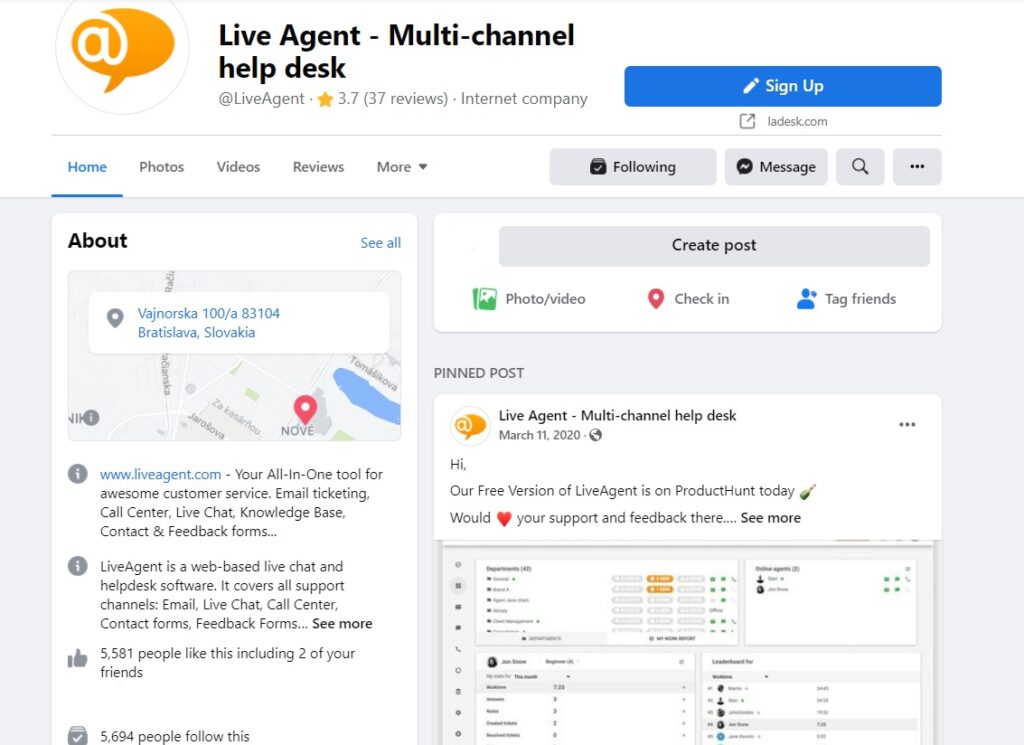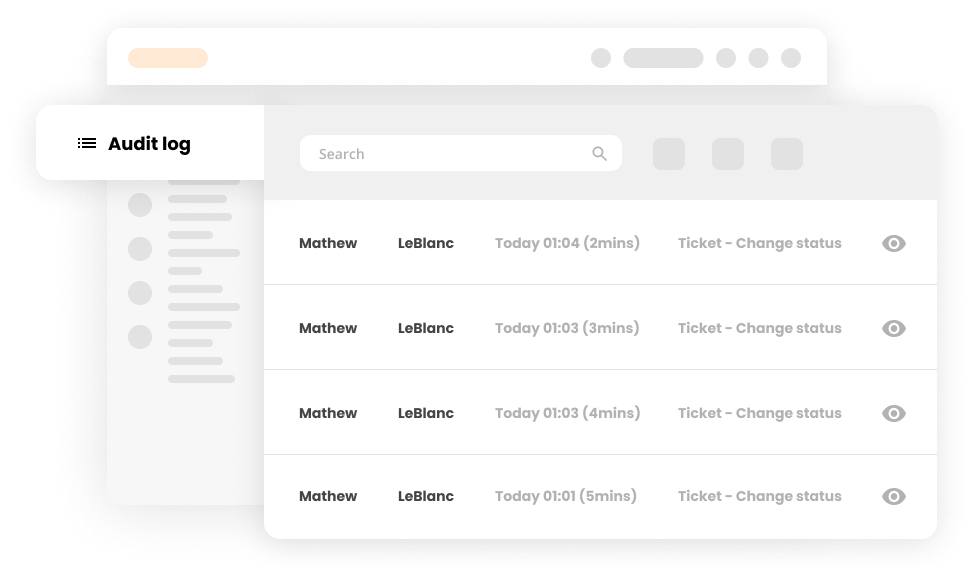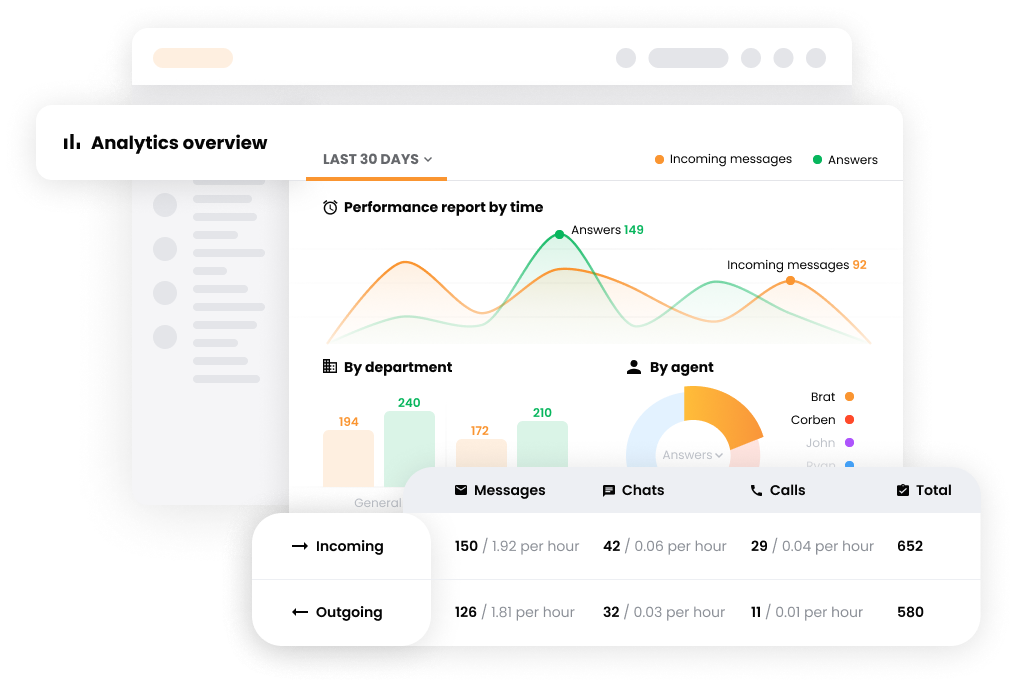- EuropaAsiaMedio Oriente
- Tutte le liste di controllo
- Marketing
- Lista di controllo per l’audit di Marketing
Lista di controllo per l’audit di Marketing
La lista di controllo per l'audit di marketing guida l'analisi delle strategie aziendali, valutando la presenza online, gli obiettivi e l'efficacia delle azioni. Offre raccomandazioni per migliorare il marketing, identificando aree di crescita e ottimizzando le risorse.

- Stabilisci il tuo target di mercato
- Fissa i tuoi obiettivi
- Analizza il mercato
- Fai un’analisi SWOT
- Valuta l’efficacia degli attuali sforzi di marketing
- Identifica il tuo USP
- Conferma il tuo budget di marketing
- Crea una strategia di marketing
- Sviluppa un piano di content marketing
- Avvicinati ai tuoi potenziali clienti con LiveAgent
- Costruisci delle risorse digitali (sito web, profili dei social media)
- Crea un piano d’azione per migliorare gli aspetti inefficaci della strategia di marketing dell’azienda
Eseguire un audit di marketing è uno dei compiti più critici per qualsiasi azienda. Non si tratta solo di spuntare delle caselle, ma piuttosto di comprendere la tua azienda e identificare ciò che stai facendo bene e dove puoi migliorare.
Se non sei sicuro di come iniziare o se ci sono delle aree critiche che dovrebbero essere affrontate prima, questa lista di controllo ti guiderà attraverso il processo.
L’importanza di una lista di controllo per l’audit di marketing
Per farla breve: un audit di marketing aiuta a valutare l’efficienza delle strategie, dei budget e di qualsiasi altro investimento nelle attività di marketing.
Con una lista di controllo di audit di marketing, puoi valutare quanto bene il tuo approccio ha funzionato per soddisfare le esigenze del mercato.
Supponiamo che tu non stia soddisfacendo la domanda dei clienti o le esigenze attuali per quanto riguarda i benefici del prodotto, la qualità, la sicurezza o gli standard di prestazione. In questo caso, vale la pena dare un’occhiata più da vicino alle potenziali aree di miglioramento.
Fare un inventario permette di valutare quanto lavoro è necessario prima di decidere se riformulare i prodotti o aumentare la produzione per il lancio di nuovi prodotti, ecc. Fare questo potrebbe far risparmiare sia soldi che tempo nel lungo periodo.
Tutto dipende dai tuoi obiettivi di pre-marketing – che si tratti della consapevolezza del marchio o del numero effettivo di ordini effettuati – quindi è essenziale avere un piano e degli obiettivi misurabili fissati in anticipo.
Un audit di marketing ti dà le linee guida per eseguire una strategia più efficace. Riduce il tempo sprecato in aree problematiche ed evidenzia le opportunità di crescita. Quindi, è possibile indirizzare efficacemente i cambiamenti con le migliori possibilità di migliorare i tassi di successo.
Chi può beneficiare di una lista di controllo di audit di marketing?
1 team di marketing
Gli audit di marketing possono aiutare il team di marketing a fissare gli obiettivi e a misurare il successo. Comprendendo quanto bene i tuoi sforzi passati hanno soddisfatto le esigenze dei clienti e se qualche area ha bisogno di maggiore attenzione, puoi impostare degli obiettivi realistici e raggiungibili nella tua prossima campagna di marketing ed evitare di commettere gli stessi errori.
2 imprenditori
I proprietari di aziende possono beneficiare di una lista di controllo di audit di marketing. Li aiuta a identificare le aree di miglioramento e a sfruttare al meglio le nuove opportunità. Anche se tutto funziona bene, è essenziale tenersi aggiornati con le tendenze del settore in modo che la tua azienda non venga colta alla sprovvista quando i concorrenti iniziano a rivolgersi ai tuoi potenziali clienti in modo più efficace rispetto a te.
Esplora la lista di controllo dell’audit di marketing
Il primo passo di qualsiasi audit di marketing è determinare la quota di mercato attuale. Ciò implica la comprensione del tuo cliente ideale, di quali esigenze si possono soddisfare e del modo migliore per raggiungerlo.
Se non sai da dove cominciare, crea una buyer persona, una rappresentazione fittizia del tuo cliente target che includa informazioni demografiche e tratti comportamentali.
Perché è importante conoscere il mercato di riferimento?
Non c’è modo di misurare il successo o il fallimento dei tuoi sforzi se non hai un’idea chiara di chi sono i destinatari del tuo marketing.
Considera quanto sei in grado di capire i potenziali clienti e le loro preoccupazioni in relazione al tuo prodotto o servizio.

Come individuare il cliente ideale?
Cerca di capire come è fatto il tuo cliente ideale e come si comporta. Puoi iniziare a considerare i tuoi clienti esistenti e stabilire il cliente ideale in base a loro. Studia i feedback ricevuti dai potenziali clienti sui canali social media utilizzando un software per il servizio clienti sui social media. Questo software può aiutarti ad analizzare e comprendere le preferenze, le esigenze e i comportamenti dei tuoi clienti, consentendoti di perfezionare i profili dei tuoi clienti e di adattare di conseguenza le tue strategie di marketing.
Quali strumenti dovresti utilizzare in questa fase?
- personas
- mappe del buyer journey
- mappe sulla customer experience
- risultati del monitoraggio dei social media
Assicurati che tutte le tue attività contribuiscano al raggiungimento di un obiettivo comune e che tu possa monitorare i progressi nel tempo.
Perché è importante stabilire degli obiettivi di marketing?
Senza obiettivi definiti, è difficile valutare se il tuo marketing ha successo o meno. Stabilisci cosa speri di ottenere con il tuo marketing e come saprai se ci sei riuscito.
Come stabilire gli obiettivi nel marketing?
Gli obiettivi devono essere specific, measurable, attainable, relevant, and time-bound (SMART). Suddividili in obiettivi a breve e a lungo termine per avere un’idea chiara di ciò che vuoi raggiungere e quando.
Quali strumenti utilizzare per la definizione degli obiettivi?
- foglio di calcolo per la ricerca di parole chiave
- Google Search Console
- report di analytics
- strumenti di reporting per i social media
Ora che hai una buona idea del tuo mercato di riferimento, è il momento di analizzare come utilizzano i servizi o i prodotti che offri. Per capire cosa pensano le persone del settore, monitora le parole chiave e le frasi pertinenti e i canali dei social media, dove i clienti parlano delle loro esigenze e preoccupazioni.
Perché è importante analizzare il mercato?
Ti aiuta a capire cosa cercano i tuoi clienti, come lo trovano e il linguaggio che usano quando parlano delle loro esigenze. Queste informazioni ti aiutano a definire le tue strategie di marketing e a creare dei contenuti che abbiano una certa risonanza.
Come analizzare il mercato?
Verifica l’andamento del tuo settore e dei tuoi concorrenti. Che cosa si dice in rete della tua concorrenza? Ci sono nuovi servizi o prodotti di cui dovresti essere a conoscenza?
Cerca un modo per distinguerti dai tuoi concorrenti e attirare più clienti.
Quali strumenti dovresti utilizzare per l’analisi di mercato?
- Avvisi di Google
- strumenti di ascolto sociale
- sondaggi online
- gruppi di discussione
Uno dei modi più efficaci per determinare le azioni di marketing da intraprendere è quello di condurre un’analisi SWOT. I punti di forza, i punti di debolezza, le opportunità e le minacce sono fattori che influenzano la capacità di commercializzare la tua azienda o la tua offerta di prodotti/servizi.
Perché è importante un’analisi SWOT?
Aiuta a concentrare gli sforzi e ad allocare le risorse nel modo più efficace.
L’identificazione delle aree deboli e forti e delle conseguenti minacce e opportunità crea una visione realistica della tua situazione attuale. Serve come punto di partenza per decidere cosa si può e si deve fare.

Come si fa un’analisi SWOT?
Elenca tutti i fattori rilevanti che potrebbero influenzarti e valutali come punti di forza, punti di debolezza, opportunità o minacce.
L’analisi SWOT deve includere un esame dettagliato di ogni area, compreso il modo in cui si relaziona con la tua strategia di marketing.
Dovrai inoltre proporre strategie per migliorare i punti di debolezza dell’azienda e capitalizzare tutte le opportunità. Ad esempio, potresti concentrarti sullo sviluppo di nuovi prodotti per sfruttare al meglio le eventuali lacune del mercato.
Quali strumenti utilizzare per l’analisi SWOT?
- software di indagine
- fogli di lavoro SWOT (si possono trovare facilmente online)
- documento di elaborazione testi
- fogli di calcolo
- software di pianificazione aziendale
- report e set di dati per ricerche di mercato
Stabilisci in che misura stai raggiungendo il tuo pubblico di riferimento. Ciò include la valutazione dell’efficacia di tutti i tuoi attuali sforzi di marketing, dal sito web e dalla presenza online alle campagne sui social media e alle newsletter via e-mail.
Perché valutare l’efficacia dei tuoi sforzi?
Ti aiuta a identificare ciò che funziona e ciò che non funziona, in modo da poter concentrare i tuoi sforzi sulle attività che portano i risultati migliori. Inoltre, consente di determinare se è necessario apportare modifiche alla strategia o alle tattiche di marketing attuali.
Come valutare i canali di marketing?
Osserva il traffico del tuo sito web, le conversioni, i follower sui social media, le aperture delle e-mail e i tassi di clic.
Senza queste metriche, può essere difficile determinare l’efficacia del tuo marketing e stabilire se sia necessario apportare delle modifiche.
Quali strumenti dovresti utilizzare per la valutazione?
- Google Analytics (per il traffico del sito web)
- sondaggi online
- software per i tassi di apertura e di clic delle e-mail
- metriche di coinvolgimento sui social media
Se sei stato in grado di condurre un’analisi dettagliata della concorrenza, allora dovresti anche aver sviluppato una comprensione di quale sia il tuo punto di vendita unico (USP).
Perché è importante conoscere la tua USP?
Il tuo punto di vendita unico ti distingue dalla concorrenza e attira i clienti che cercano qualcosa che nessun altro offre. Nell’ambito del tuo audit di marketing, dovrai analizzare la tua USP ed elaborare un piano per sfruttarla al meglio (se non lo hai già fatto).
Come identificare la tua USP?
Stila un elenco di tutti i modi in cui ti differenzi dai tuoi concorrenti e poi cerca di capire come comunicare queste differenze ai potenziali clienti. Questo può essere fatto attraverso il tuo sito web, i post sui social media, le newsletter via e-mail e persino il materiale di vendita. Sviluppa una dichiarazione chiara e concisa che spieghi i tuoi punti di vendita unici e fai riferimento ad essi.
Quali strumenti dovresti utilizzare per la USP?
- documenti di elaborazione dei testi
- sondaggi online
- software per i tassi di apertura e di click delle e-mail (se li utilizzate)
- campagne di marketing virale (social media, newsletter via e-mail, ecc.)
- post di blog o articoli sul tuo sito web
- brochure e volantini di vendita
- comunicati stampa
- eBook o whitepaper
Ora che hai una buona conoscenza del tuo mercato di riferimento, della USP e degli attuali sforzi di marketing, è il momento di verificare il tuo budget di marketing. In questo modo ti assicurerai di avere a disposizione i fondi da destinare alle attività che hanno buone probabilità di successo.
Perché è importante stabilire un budget di marketing?
È fondamentale avere un’idea realistica di quanto puoi permetterti di spendere in marketing per ottenere i risultati desiderati.
Come decidere il budget per il marketing?
Esamina il tuo budget attuale e cerca di capire quanto puoi destinare alle attività di marketing ogni mese o trimestre. Dovresti anche sviluppare un piano per l’allocazione dei budget di marketing in base agli approcci a cui dai priorità. Ad esempio, se il social media marketing è la tua priorità assoluta, dovresti destinare i fondi ad attività come il pagamento di annunci o la crescita della tua base di follower.
Quali strumenti dovresti utilizzare per stabilire un budget di marketing?
- documenti di elaborazione testi
- sondaggi online
- software per i tassi di apertura e di click-through delle e-mail (se li utilizzate)
- fogli di calcolo (per la creazione di budget)
È inevitabile delineare le azioni specifiche da intraprendere per raggiungere gli obiettivi aziendali.
Perché è importante avere una strategia di marketing?
Ti aiuterà a concentrare i tuoi sforzi, ad allocare le risorse nel modo più efficace e a monitorare i progressi nel tempo.
Come si elabora una strategia di marketing?
Includi un piano dettagliato per ciascuna delle fasi descritte in questa guida. Specifica il tempo che darai a ciascuna attività per produrre risultati e stabilisci gli obiettivi che vorresti raggiungere.
Quali strumenti dovresti utilizzare in questa fase?
- software di gestione delle relazioni con i clienti (CMS)
- software per l’ottimizzazione dei motori di ricerca (SEO)
- social media
- pubblicità online
Uno dei modi più efficaci per migliorare il tuo marketing è quello di sviluppare una strategia di contenuti. Questa delinea i tipi di contenuti che produrrai e la frequenza con cui intendi pubblicarli.
Perché è importante una strategia di contenuti?
I contenuti di qualità sono essenziali per qualsiasi strategia di marketing di successo. Incoraggiano le decisioni di acquisto, aiutano a educare i potenziali clienti sulla tua azienda e creano fiducia.

Come fare un piano di content marketing?
Inizia creando un elenco dei tipi di contenuti che vuoi produrre, compresi i post del blog, gli aggiornamenti dei social media e i video. Inoltre, sviluppa un calendario editoriale per ogni piattaforma, in modo da definire chiaramente il tuo programma.
Quali strumenti dovresti utilizzare in questa fase?
- piattaforma di blogging e CMS (se le utilizzi)
- strumenti di gestione dei social media come Kontentino per aiutarti a gestire i contenuti in modo efficace
Assicurati che i tuoi clienti possano raggiungerti facilmente e ottenere tutte le informazioni importanti senza problemi.
Perché è importante avvicinarsi ai tuoi potenziali clienti?
Perché aiuta a costruire delle relazioni migliori. I clienti si fidano di più quando sanno di poter contare su di te ogni volta che hanno bisogno del tuo aiuto.
Come avvicinarsi ai tuoi potenziali clienti?
Puoi utilizzare molti metodi diversi per semplificare la possibilità dei tuoi clienti di contattarti. Si va da quelli visibili ai clienti, come i widget per la live chat, a quelli che aiutano i tuoi agenti a gestire il loro carico di lavoro in modo più efficiente, aumentando così la soddisfazione dei clienti.
LiveAgent li offre tutti – puoi utilizzare un software per call center integrato, acquisire più contatti con la live chat più veloce del mercato e gestire tutte le chat, i messaggi, le e-mail, le chiamate, ecc. da un’unica casella di posta.

Quali strumenti puoi utilizzare per avvicinarti ai tuoi potenziali clienti?
- Software per call center
- Live chat
- Software di assistenza sui social media
Ora che hai un piano per i tuoi contenuti, è il momento di creare le risorse digitali necessarie per realizzarli.
Perché è necessario creare delle risorse digitali?
È essenziale assicurarsi che tutti i profili dei social media e le pagine del sito web siano aggiornati, in modo da attirare i visitatori e tenerli impegnati con il tuo marchio. Questo aiuterà anche la tua azienda ad apparire più professionale e credibile.

Come gestire un buildout?
Si dovrebbe iniziare creando o aggiornando il sito web e i profili dei social media. A tal fine, è necessario aggiungere delle informazioni pertinenti, come la descrizione dell’attività, i dettagli di contatto e le immagini o i loghi. Inoltre, assicurati che tutte le tue pagine siano collegate tra loro, in modo che i visitatori possano navigare facilmente tra di esse.
Quali strumenti utilizzare per la creazione di risorse digitali?
- software per la creazione di siti web
- strumenti di gestione dei social media (come Hootsuite o Kontentino)
- software di progettazione grafica (ad esempio Adobe Photoshop)
- software di editing video (come Adobe Premiere Pro)
Dopo aver acquisito una solida conoscenza della tua attività e del mercato, è il momento di creare un piano d’azione per migliorare la tua strategia di marketing. In questo modo si delineeranno i passi specifici da compiere per migliorare gli aspetti inefficaci del tuo marketing.
Perché è importante un piano d’azione?
Aiuta a individuare i margini di miglioramento e a pianificare i cambiamenti più opportuni.
Come si fa un piano d’azione?
Il piano d’azione deve includere una revisione dettagliata di ogni aspetto inefficace della tua strategia di marketing, insieme alle misure che puoi adottare per migliorarlo.

Quali strumenti utilizzare in questa fase?
- modello o foglio di lavoro per la strategia di marketing digitale
- software di pianificazione delle azioni come Trello
- modelli di report (come i report di marketing) per monitorare i progressi nel tempo e condividerli con i membri del team e il capo, ecc.
Elementi essenziali di un audit di marketing
Obiettivo dell’audit
Definisci lo scopo del tuo audit. Gli obiettivi di un audit di marketing variano, ma tipicamente includono:
- Valutazione dell’efficacia delle campagne di marketing digitale passate.
- Determinare i punti di forza e di debolezza della tua attuale strategia di marketing.
- Analizzare i feedback e i reclami dei clienti.
- Monitorare l’attività dei concorrenti.
Portata dell’audit
Dopo aver capito l’obiettivo, è il momento di determinare la portata del tuo audit. Decidi cosa includere e cosa tralasciare. Questo ti aiuterà a rimanere in carreggiata durante la conduzione dell’analisi. Alcuni fattori da considerare sono:
L’arco temporale dell’audit – un anno intero, 6 mesi o solo uno?
Ambito geografico – quali paesi/regioni saranno inclusi tua analisi?
Focus sul prodotto – quali prodotti o servizi esaminerai?
Mercato di riferimento – chi è il tuo pubblico di riferimento?

Metodi di audit
Una volta che sai cosa dovrai guardare, è il momento di determinare il modo migliore per raccogliere le informazioni. Ci sono vari metodi di audit disponibili. Scegli quello che funzionerà meglio per le tue esigenze.
Alcuni metodi di controllo standard includono:
Esaminare i documenti aziendali – relazioni finanziarie, piani di marketing, dati dei clienti.
Fare delle indagini sui clienti – tramite interviste, focus group o sondaggi.
Monitorare l’attività online – analytics del sito web, metriche dei social media, ecc.
Effettuare dei Confronti con la concorrenza – studio delle loro strategie e tattiche di marketing.
Analizzare i dati finanziari – crescita dei ricavi, margini di profitto, ecc.
Analisi e conclusioni
Scopri se i tuoi obiettivi sono stati raggiunti o meno e quali cambiamenti, se ce ne sono, devono essere fatti. Assicurati di presentare i tuoi risultati in modo chiaro e conciso per essere facilmente compreso dalla direzione.
Alcuni metodi di analisi standard includono:
- Creare un’analisi SWOT – punti di forza, debolezza, opportunità e minacce.
- Costruire un’analisi PESTEL – fattori politici, economici, sociali, tecnologici, ambientali e legali che potrebbero influenzare la tua azienda o il tuo settore.
- Sviluppare un piano d’azione con raccomandazioni per il miglioramento.

Raccomandazioni
Quando si tratta di raccomandazioni, vorrai includere passi specifici che possono essere fatti per affrontare i problemi identificati nel tuo audit. Questo ti assicurerà di sapere cosa deve essere fatto e quale piano seguire. Assicurati che le tue raccomandazioni siano realizzabili e realistiche in modo che possano essere attuate direttamente.
Piano d’implementazione
Metti insieme un piano di implementazione. Definisci chi è responsabile per ogni azione, quali risorse sono necessarie e una linea temporale per quando i compiti devono essere completati. Un piano di implementazione ben organizzato ti aiuterà a garantire che i cambiamenti siano fatti in modo tempestivo ed efficace.
Valutazione
Una volta che i cambiamenti sono stati fatti, è il momento di valutarne l’efficacia. Questo è il momento in cui determinerai se i tuoi obiettivi sono stati raggiunti o meno e se ci sono stati degli intoppi lungo la strada.
Metriche di audit di marketing
Tassi di conversione
I tassi di conversione sono la misura più precisa dell’efficacia della tua campagna di marketing. È possibile calcolare i tassi di conversione in base a:
Vendite – il monitoraggio degli acquisti e delle vendite del sito web attraverso una piattaforma di e-commerce o un sistema CRM mostrerà quanti clienti hanno effettuato un acquisto dopo aver visualizzato pagine/contenuti specifici.
Lead – misura quanti lead sono stati generati come risultato delle tue attività di marketing, e poi monitora quanti di questi si sono tradotti in una vendita.
Iscrizioni – traccia il numero di persone che si iscrivono alla ltua ista e-mail o che scaricano un white paper o un e-book, ecc.
Click – misura il numero di clic sui tuoi annunci (impressioni) e il numero di conversioni che ne derivano.

Frequenza di rimbalzo
La frequenza di rimbalzo è una metrica usata per tracciare il numero di persone che visitano il tuo sito e lo lasciano immediatamente. Può aiutarti a capire se stai attirando il pubblico giusto o meno.
La frequenza di rimbalzo è determinata prendendo il numero totale di visitatori che lasciano il tuo sito dopo aver visto una pagina e dividendolo per il numero totale di visite. Se questa percentuale è alta, potrebbe esserci qualcosa sul tuo sito web che spegne le persone o le allontana prima che abbiano la possibilità di esplorare ulteriormente. Per ridurre la frequenza di rimbalzo, prova a:
Elimina i contenuti superflui dalle landing page – verifica quali elementi aumentano le conversioni senza aumentare la frequenza di rimbalzo prima di rimuoverli completamente.
Rendi le tue call-to-action più convincenti – chiarisci esattamente cosa i visitatori otterranno in cambio del loro tempo e dei loro sforzi.
Aggiungi dei parametri di sicurezza – prendi in considerazione l’utilizzo di badge di sicurezza, loghi dei clienti, testimonianze e così via, per aumentare la fiducia dei visitatori.

Tasso di click-through
Il click-through rate (CTR) è una metrica utilizzata per misurare il numero di clic sui tuoi annunci e quante persone visitano il tuo sito web come risultato. Il monitoraggio può aiutarti a identificare quali formati di annunci, posizionamenti o network guidano meglio il traffico verso il tuo sito. Per migliorare il CTR:
Testa diversi formati di annunci e posizionamenti – prova a utilizzare un mix di annunci di testo, immagini e video per vedere quali generano il maggior numero di clic.
Monitora il traffico del tuo sito web – cerca i picchi di traffico che coincidono con l’aumento della spesa pubblicitaria per determinare quali annunci stanno funzionando meglio.
Regola le offerte – se non ottieni il CTR desiderato, aumenta o diminuisci le tue offerte per migliorare o ridurre la tua visibilità.

Sforzi sui social media
I social media sono uno strumento potente per il marketing del tuo business. Possono aiutarti a raggiungere nuovi clienti, a costruire delle relazioni con i clienti attuali e a generare lead. Per ottenere il massimo dai social media:
Crea dei contenuti interessanti e coinvolgenti – condividi post di blog, infografiche, immagini e video, ecc. per catturare l’attenzione delle persone.
Partecipa alle conversazioni – unisciti alle discussioni pertinenti per aumentare la consapevolezza del tuo marchio da parte dei clienti.
Misura e traccia i risultati – monitora gli analytics dei social media (ad esempio, Facebook insights) per vedere quante persone si impegnano con te su ogni piattaforma e i tipi di post che portano più traffico al tuo sito web.
Sforzi di vendita
Le vendite sono l’obiettivo finale dei tuoi sforzi di marketing. Il monitoraggio delle metriche di vendita ti aiuterà a capire se le tue campagne portano nuovi clienti e aumentano i tassi di ritenzione dei clienti. Il monitoraggio delle metriche di vendita può essere fatto attraverso:
Piattaforme eCommerce – utilizza strumenti come Shopify, Bigcommerce, ecc. per tracciare gli acquisti di prodotti su più negozi/siti web.
Strumenti di email marketing – usa uno strumento come Sender.net, Mailchimp o Constant Contact per tracciare il numero di vendite risultanti dalle campagne email, così come il valore di vita del cliente e il ROI per ogni campagna eseguita.
Collabora con il tuo team finanziario – in modo che possa condividere i dati sui nuovi clienti acquisiti grazie ai tuoi sforzi e sul numero di vendite che realizzi in media.
Metriche di consapevolezza del marchio
Migliorare la consapevolezza del marchio è un processo continuo che richiede tempo e sforzi costanti per vedere i risultati. Per monitorare i tuoi progressi:
Confronta metriche simili – confronta i dati dello stesso mese/trimestre dell’anno precedente (o più vecchio) con i dati attuali per vedere i progressi fatti.
Utilizza i sondaggi Brand Lift – si tratta di questionari che chiedono alle persone se hanno sentito parlare del tuo marchio e, in caso affermativo, se ne hanno un’impressione positiva o negativa.
Monitora le menzioni sui social media – usa strumenti come Hootsuite o Mediatoolkit per misurare il numero di volte in cui il tuo marchio viene citato online.
Monitora la posizione del tuo marchio nei risultati di ricerca – monitora la frequenza con cui la tua azienda appare in cima a Google, Bing, ecc. per vedere quale parola chiave target sta portando traffico e vendite al tuo sito web.
Riassunto della lista di controllo dell’audit di marketing
- Stabilisci il tuo target di mercato
- Fissa i tuoi obbiettivi
- Analizza il mercato
- Fai un’analisi SWOT
- Valuta l’efficacia degli attuali sforzi di marketing
- Identifica il tuo USP
- Conferma il tuo budget di marketing
- Crea una strategia di marketing
- Sviluppa un piano di content marketing
- Avvicinati ai tuoi potenziali clienti con LiveAgent
- Costruisci delle risorse digitali (sito web, profili dei social media)
- Crea un piano d’azione per migliorare gli aspetti inefficaci della strategia di marketing dell’azienda
Elementi essenziali di un audit di marketing:
- Obiettivo dell’audit
- Portata dell’audit
- Metodi di audit
- Analisi e conclusioni
- Raccomandazioni
- Piano d’implementazione
- Valutazione
Metriche di audit di marketing:
- Tassi di conversione
- Frequenza di rimbalzo
- Tasso di click-through
- Sforzi sui social media
- Sforzi di vendita
- Metriche di consapevolezza del marchio
Frequently Asked Questions
Cosa chiedere in un audit di marketing?
Un audit di marketing dovrebbe coprire tutti gli aspetti della tua attività di marketing, dalla consapevolezza del marchio al processo di vendita. Dovrebbe anche includere una revisione del tuo sito web, della piattaforma di eCommerce e della presenza sui social media. Come si può notare, gli aspetti da coprire sono molti e si consiglia di lavorare in team, compresi i reparti di finanza e contabilità. La nostra lista di controllo riassume tutti i punti chiave da trattare nell’audit.
Come si recuperano le campagne di marketing fallite?
Se non stai ottenendo i risultati desiderati dalle tue campagne attuali, prova a fare dei test A/B su diversi formati di annunci e posizionamenti (ad esempio, annunci di testo o di immagini). Inoltre, monitora il traffico del sito web per individuare eventuali picchi di inattività e cercate le tendenze per determinare quali annunci portano nuovi clienti. Potrebbe anche essere una buona idea rivedere il design del tuo sito web, la strategia dei contenuti o le parole chiave SEO per vedere dove è possibile migliorare.
Come ci si prepara a un audit di marketing?
Il modo migliore per prepararsi a un audit di marketing è raccogliere tutti i dati rilevanti e tenerli pronti per la revisione. Questo include gli analytics del tuo sito web, della piattaforma di eCommerce, degli account dei social media e degli strumenti di email marketing. Dovresti anche avere tutti gli asset di branding o di design pronti per essere esaminati, così come una panoramica delle tue campagne attuali e dei loro risultati. Puoi scaricare gratuitamente la nostra lista di controllo per l’audit di marketing in formato PDF, che include un riepilogo di tutti i punti chiave da trattare nell’audit.
Di quanto tempo ho bisogno per completare con successo un audit di marketing?
Anche in questo caso, non esiste una risposta definitiva a questa domanda. Tuttavia, è necessario prevedere un tempo sufficiente per esaminare tutti i dati e formulare raccomandazioni per il miglioramento. Utilizzando la nostra lista di controllo per l’audit del marketing digitale, potrai ridurre questo tempo al minimo, perché non dovrai apportare ulteriori modifiche e non dovrai tralasciare nulla di cruciale.
Come si formatta un audit di marketing?
Non esiste una risposta univoca a questa domanda, poiché il formato di un audit di marketing varia a seconda delle dimensioni e della complessità dell’azienda. Tuttavia, la maggior parte degli audit comprende Sintesi: una breve panoramica dei punti chiave dell’audit, comprese le raccomandazioni e i passi successivi. Attività di marketing corrente – una panoramica di tutte le campagne di marketing in corso e completate, nonché del loro successo nel promuovere le vendite. Obiettivi di marketing: informazioni dettagliate sugli obiettivi aziendali per ogni tipo di campagna, in modo da comprendere chiaramente ciò che si sta cercando di ottenere. Revisione delle attività di marketing – una valutazione, ad esempio, del design del tuo sito web, dell’esperienza utente, dei contenuti, del SEO, dei social media e della strategia di email marketing. Analisi finanziaria – un esame di quanto stai spendendo per il marketing e se questo sta generando o meno un buon ritorno sull’investimento (ROI). Prossimi passi – raccomandazioni per migliorare l’attività di marketing in base ai risultati dell’audit.
Qual è il ruolo dell'audit dell'email marketing nell'audit del marketing digitale?
L’e-mail marketing è uno dei canali più importanti del marketing digitale. È un ottimo modo per entrare in contatto con i clienti e tenerli aggiornati sui tuoi ultimi prodotti e servizi. La verifica dell’email marketing è una parte essenziale per mantenere una campagna di successo.
You will be
in Good Hands!
Join our community of happy clients and provide excellent customer support with LiveAgent.

Il nostro sito web utilizza i cookie. Continuando a navigare sul nostro sito ti informiamo che assumeremo il tuo consenso all'utilizzo dei cookie come specificato nella nostra politica della privacy e dei cookie.

- How to achieve your business goals with LiveAgent
- Tour of the LiveAgent so you can get an idea of how it works
- Answers to any questions you may have about LiveAgent

 Български
Български  Čeština
Čeština  Dansk
Dansk  Deutsch
Deutsch  Eesti
Eesti  Español
Español  Français
Français  Ελληνικα
Ελληνικα  Hrvatski
Hrvatski  Latviešu
Latviešu  Lietuviškai
Lietuviškai  Magyar
Magyar  Nederlands
Nederlands  Norsk bokmål
Norsk bokmål  Polski
Polski  Română
Română  Русский
Русский  Slovenčina
Slovenčina  Slovenščina
Slovenščina  简体中文
简体中文  Tagalog
Tagalog  Tiếng Việt
Tiếng Việt  العربية
العربية  English
English  Português
Português 
